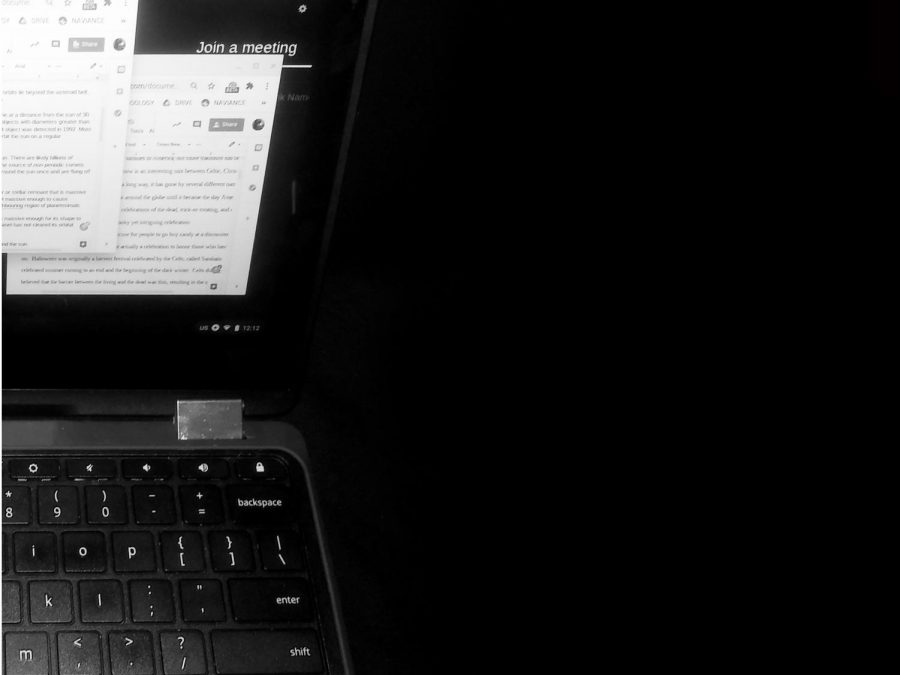Point-Counterpoint: Remaining Remote
November 17, 2020
On October 9, District 156 announced that the school would pivot to their hybrid learning plan in November. As the news made its way through the school community, many students expressed excitement about meeting their teachers and seeing their friends again. Others, though, weren’t as excited; remote learning offered them flexibility and freedom as learners, and they were worried they’d slip back into bad learning habits when everyone was back in the building.
It only took a few weeks for COVID to force the district to reconsider its plans. For the time being, the district will remain remote. Though students and teachers are working hard to make it successful, learning through Schoology and Zoom isn’t an ideal for some learners even as others thrive in a remote learning environment.
Remote learning hasn’t been easier, but it has helped some students remain organized and push themselves to succeed.
Pro: Remote learning gives students more control
Although Illinois’s state-wide quarantine has been received with mixed-emotions, it has turned out to be a chance for students to experience what learning from home is like. As controversial as it may be, remote learning stands as the superior learning style. It is accessible, less stressful than “normal school”, and it allows for students to take greater control of their learning experience.
COVID has forced people from all different walks of life to live and work from home; students, workers, and otherwise. As a result, this has made school and work more accessible for those who have difficulties coming to the place they need to be, whether they be physical or emotional. For some MCHS students, remote learning is just a continuation of what they had already been doing.
“During freshman year I did full-time regular schooling, but with mental health issues and just having a general bad time, it was really really hard to focus and do what I needed to do” senior Noah Koch says. “Junior year, I switched to partial homebound. I would go to school for four periods to complete the classes I couldn’t do at home. Then, after fourth period, I would go home and finish the rest of my classes.”
Instead of completing all of his classes one after another, and having to physically be in the classroom, Koch was able to give himself breaks throughout the day and do what worked for him. Koch believes that all students should have this option, as no student learns exactly the same.
“There are kids who are helped by actually going to a school and being in a learning environment, and that’s great. But, a lot of kids get so distracted by having other people there.”
Koch also believes that his choice was immensely helpful in his ability to be the student he wanted to be.
“Beforehand, just having the looming due date, being distracted by others in class, and having to explain to my teachers face-to-face why I wasn’t able to complete work sometimes was so overwhelmingly stressful.” Koch states. “Now, I’m able to finish all my work when I have bursts of energy, I’m ahead in math, and I’m on track to graduate in December.”
Before March of this year, many students had never experienced what it was like to be homeschooled, as it didn’t seem to be an option. In many high schools, there has to be a solid reason or event leading to why a student is learning from home, senior Becky Arendarczyk explains.
“I know that if you´re a 504 kid you can opt out of doing school in-person. I have friends who do because of mental or physical health issues.” Arendarczyk says. “If this year had been ‘normal,’ I probably would’ve been remotely learning anyways.”
As cases spike and people start traveling, visiting family, and getting sick with common cold weather ailments, the likelihood of MCHS returning to school seems small. But, even if MCHS students convert to a hybrid option, M and other students will still have to stay home from school.
“They had it set up that if you or a family member was immunocompromised, or you had a 504 plan, you would stay learning remotely,¨ Arendarczyk states. ¨They just thought it´d be easier for people´s accommodations.”
This year has proven to be increasingly difficult for students with accommodations, as the uncertainty of what accommodations are needed as well as how they will be provided for has been a topic of debate.
“I had to make so many phone calls. My school therapist originally was making accommodations for me for the hybrid plan at the beginning of the school year, and then we weren’t doing hybrid. Then, we were going to go back to hybrid. And then we weren’t.”
But, remote learning has allowed Arendarczyk to feel more comfortable doing her schoolwork, as she too is set to graduate in December.
Remote learning has a plethora of different positives to it that may not have been considered beforehand. It allows students to take control of their time, their energy, and their learning experience. If remote learning were in different circumstances, it’s almost guaranteed that it would be much more popular than it is. But, of course, it’s understandable that remote learning has been given a bad reputation. After all, no one likes being forced into a school environment that does not work for them now, do they?
Neither students nor teachers were ready for an entirely remote school year, and everyone is still scrambling to make it work.
Con: Remote learning doesn’t work for most students
High school is a time of getting to be with your friends, experience different things, and do hands-on experiments and learn about things that will help you post secondary school. But what happens when all of that is stripped from you? Much like today, we don’t have a majority of what we need to be successful, and that is why remote learning doesn’t work.
Ever since May, remote learning has been a struggle for many, especially those who are procrastinators and can’t find the motivation to do work. Many of the issues occurring from remote learning is a lack of resources, heavy workloads, wifi issues, and no guaranteed form of communication.
Many people say that remote learning is easy for them. Some students with special education plans, for example, get extra support; other students who may be bullied at school feel safer learning from home. Still, for the majority it seems to be harder. According to Darienn Pitt, a staff columnist for The Crimson White, “All in all, online learning makes it harder for students to learn as their traditional educational environment is pretty much gone. The workload is completely up to them to complete, and they are expected to act as if they are still in their normal classroom.”
Pitt has done his research by interviewing classmates and fellow peers, and has found that the majority struggles with online learning. He adds, “And, some classes just cannot be taught online. Science classes are a great example, as it is often necessary to complete a lab to understand the material. This is not possible to do in most homes, and it makes science extremely difficult for students to comprehend through a screen.” Even at our school, sciences classes such as AP Environmental or other classes expect students to do their own labs at home, even when they don’t have the proper equipment to do it.
Another issue with remote learning is that the internet can be unreliable. Have you ever been in the middle of class taking notes for your test when all of a sudden your phone freezes? That moment is a panic moment because students can’t obtain some important information that they need to know. Some students have to learn alongside siblings and parents, so the volume and the internet bandwidth limitaions can be very rough.
Lastly, the amount of homework being given by teachers seems to be unresonable. During a Kahoot session in the Honors American Studies II English class with Joseph Dundovich, there were two questions that stuck out to me the most. The first question was along the lines of, “Do you think teachers give out too much homework?” and a majority of the students answered yes. The following question was along the lines of, “Do you feel that you’re turning things in on time?” and a majority of the students answered no. This goes to show that students have been struggling with workloads, and maybe it’s because they’re getting too much of it.
Remote learning most certainly isn’t for everyone, and it is a huge change. Learning in person is more healthier and educational for students.

